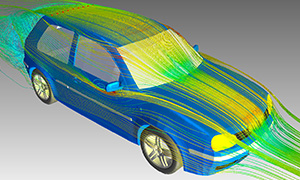Verification: The Proof is in the Pudding
Reducing the drag coefficient of vehicles results in a reduction in the fuel burn.
With over 30 years and over 30 patents in fluid form product design, we decided to run the numbers on the AeroHance PODs Project.
We asked the world’s largest independent service provider of engineering simulation to tell us what happened to a vehicle traveling 35 and 65 mph when a kit of AeroHance Pods was placed across its rear roofline. For 8 days, 4 hours, and 3 minutes, their supercomputer crunched the numbers and found that AeroHance Pods reduced the vehicle’s drag coefficient by between 5.2% and 6.7%. That leads to a huge improvement in gas mileage from something so simple!
Field Tests

How it Works/Process
The most apparent areas for drag generation are above the front windshield and behind a vehicle. Its engine must work harder to overcome that drag. Place a kit of AeroHance Pods at, or in front of these places, and some of their aerodynamic effects transfer to the vehicle. Whether new or old, with its engine fueled by gas, diesel, or electricity, making a vehicle more aerodynamic reduces its workload, which translates into an increase in gas mileage.
Reducing that drag saves fuel. AeroHance Pods are aerodynamic, pod-like devices, that when placed before the point where turbulence forms, enhance the flow of air to make the vehicle more aerodynamic. The more aerodynamic the vehicle, the easier it is to power through the air. According to auto industry experts,
For a full-size truck, a change in a drag coefficient of 0.01 is approximately equal to an improvement in fuel economy of 0.1 mpg on the combined city/highway driving cycle, … The same drag coefficient reduction can improve a car’s fuel economy by approximately 0.2 mpg.” (Improving Aerodynamics to Improve Fuel Economy at Edmunds.com, 05/05/2009)
Survey Characteristic
In “How to Prove AeroHance Pods Work To Save Fuel” and “Wind Tunnel Tests, Black Holes and AeroHance Pods,” we shared results from the computational fluid dynamic analysis of AeroHance PODs placed on a Volkswagen Golf Body. 8 days and 4.5 hours of computer crunching revealed a 5.2% – 6.7% reduction in the drag coefficient of the vehicle. That is huge!



No one will argue that decreasing the drag coefficient lessens the load on the engine, thereby increasing its fuel efficiency. The question is, how much? Since many variables affect fuel consumption, it is almost impossible to calculate fuel savings from drag reduction alone. One of three researchers, with a Ph.D. in aeronautical engineering, signed off on the compliance of the study with industry standards calculated the fuel savings and made a prediction: By enhancing a car’s aerodynamic efficiency with AeroHance Pods, placed as tested, there would be a 1.3 mpg savings.
General Results
Another way to ask the question is, “Do AeroHance Pods Work?” Answer: Your engine works. AeroHance Pods are passive, and simply by being placed to reduce that drag, they help the engine to work less, which reduces its energy needs.


